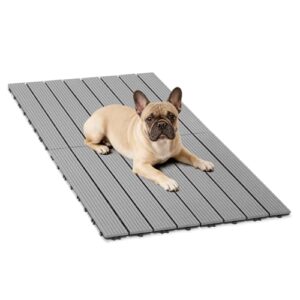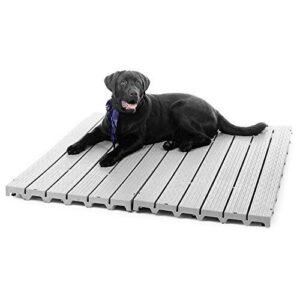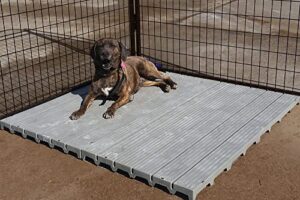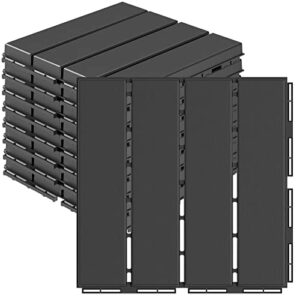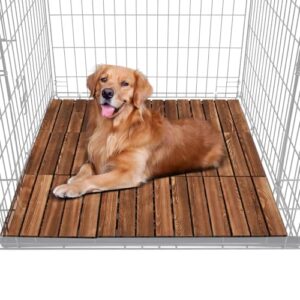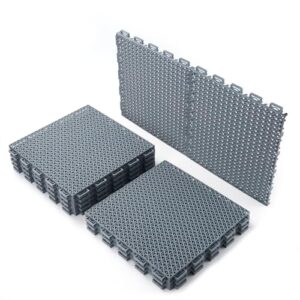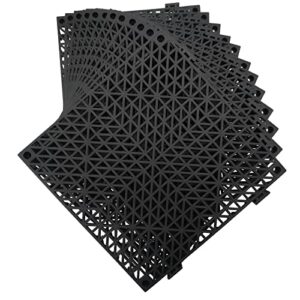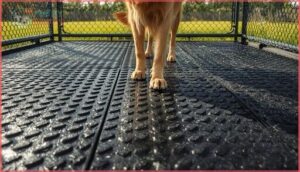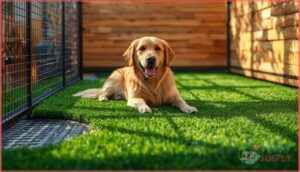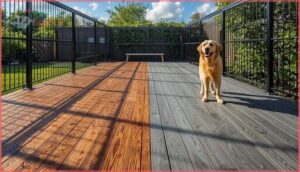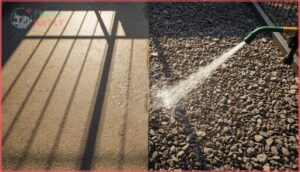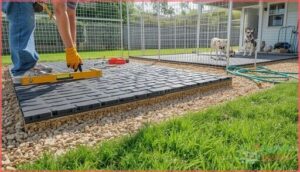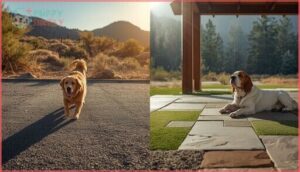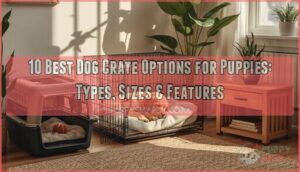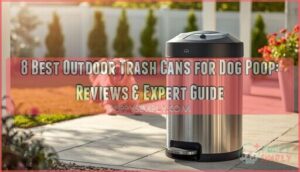This site is supported by our readers. We may earn a commission, at no cost to you, if you purchase through links.
Your dog deserves a kennel floor that won’t trap urine, harbor bacteria, or turn into a muddy mess after every rainstorm. The wrong surface creates health risks, from paw infections to respiratory problems caused by ammonia buildup. Yet most pet owners install whatever’s cheapest or easiest, only to replace it within a year when the flooring cracks, retains odors, or becomes impossible to sanitize.
The best floor for outdoor dog kennel setups balances drainage, durability, and comfort—three factors that directly impact your dog’s health and your maintenance workload. Material choice matters more than you might think: rubber offers joint protection but can retain heat, while plastic tiles drain well but may crack in freezing temperatures. Your climate, your dog’s size and habits, and your cleaning routine all determine which option will actually work for your situation.
Table Of Contents
- Key Takeaways
- Key Factors in Choosing Outdoor Kennel Flooring
- Top Outdoor Dog Kennel Flooring Products
- Comparing Popular Kennel Flooring Materials
- Installation and Maintenance Tips for Kennel Flooring
- Matching Kennel Flooring to Your Dog’s Needs
- Frequently Asked Questions (FAQs)
- How can I make the kennel flooring safer for my dog?
- Are there any environmentally friendly flooring options?
- Are there any flooring options that require minimal maintenance?
- Are there any flooring options that are suitable for both indoor and outdoor kennels?
- Are there any flooring options that are suitable for dogs of all sizes?
- Can I install flooring over existing concrete?
- How thick should outdoor kennel flooring be?
- Whats the best flooring for multiple dogs?
- Does kennel flooring prevent dogs from digging?
- Are heated flooring options available for winter?
- Conclusion
Key Takeaways
- Choose flooring that balances drainage, durability, and comfort—rubber mats cushion joints but retain heat, while plastic tiles drain well but may crack in freezing temperatures, so match the material to your climate and dog’s needs.
- Prioritize surfaces with built-in drainage systems like interlocking tiles with gaps or raised panels, graded at a 1–2% slope, to prevent bacteria growth and ammonia buildup that cause respiratory problems and paw infections.
- Verify all materials are non-toxic and pet-safe by checking for food-grade rubber, BPA-free plastics, or sealed composites with low-VOC finishes, since your dog contacts these surfaces daily.
- Plan for long-term costs by weighing upfront investment against lifespan—concrete lasts 40+ years at $4–8 per square foot, while rubber mats cost $3–8 but need replacement every 5–20 years depending on quality and use.
Key Factors in Choosing Outdoor Kennel Flooring
The right kennel floor protects your dog from injuries, illness, and discomfort while making your life easier. You’ll need to think about how water drains, what keeps paws safe, and how well materials hold up to weather and daily wear.
These five factors will guide you toward flooring that works for both you and your dog.
Drainage and Moisture Control
Without proper water drainage, your kennel becomes a breeding ground for bacteria and mold. Look for flooring with built-in drainage systems—interlocking tiles with gaps, porous surfaces, or raised panels work best. Grade your surface with a 1–2% slope away from the structure to control runoff.
Good drainage matters even more if you’re feeding your pup outdoors—spilled kibble and water bowls can turn swampy fast, especially with high-quality food for breeds like Havanese that tends to be richer and messier.
Moisture barriers beneath decking prevent ground water from seeping up, keeping the space dry and easy cleaning becomes manageable. Ensuring the kennel’s flooring has a methodological rigor is essential for maintaining a safe and healthy environment.
Comfort and Safety for Dogs
Your dog’s comfort and safety matter just as much as drainage. Choose outdoor dog kennel flooring with cushioned surfaces to protect paw safety and support joint health—hard surfaces increase strain during play. Look for these safety features:
- Non-slip, waterproof textures prevent injuries during rough play
- Heat-dissipating materials avoid burned paws in summer
- Smooth edges eliminate cuts and scrapes
Pet comfort and safety directly impact dog wellness and injury prevention. Understanding language patterns can also help in researching the best materials for outdoor dog kennels.
Durability and Weather Resistance
Comfort alone won’t cut it if your flooring falls apart in six months. You need outdoor dog kennel flooring built to handle freeze–thaw cycles, UV exposure, and relentless paw traffic.
Look for materials with proven weather resistance and structural integrity—rubber and UV-stabilized polymers usually outlast soft plastics. Proper waterproofing and interlocking designs prevent warping in damp climates, ensuring outdoor longevity through every season.
Ease of Cleaning and Maintenance
A floor that lasts means nothing if you can’t keep it clean. Look for sanitary surfaces that resist odor and simplify kennel maintenance. Outdoor dog kennel flooring with quick drainage and smooth finishes cuts your cleaning time considerably.
Pair this with regular disinfecting using a pet-safe cleaner for puppy diarrhea to keep bacteria at bay and protect your dogs’ health.
- Interlocking deck tiles allow water to drain fast, preventing moisture buildup
- Rubber surfaces resist absorbing odors and support easy disinfection techniques
- Non-porous plastics rinse clean with mild detergent, no special equipment needed
Raised panels boost airflow underneath, helping surfaces dry between maintenance schedules.
Non-Toxic and Pet-Safe Materials
The surfaces your dog touches every day deserve careful scrutiny. Toxicity testing and material certification help you identify genuinely safe flooring options. Look for pet safety labels on nontoxic coatings, especially epoxy or rubber products.
Many of these protective floor treatments also support comprehensive arthritis care for dogs by reducing joint strain during daily movement.
| Material Type | Key Safety Feature |
|---|---|
| Food-grade rubber | Closed-cell, no chemical leaching |
| BPA-free plastics | Antimicrobial additives, certified safe |
| Sealed composites | HDPE or low-VOC finishes |
| Natural stone | Pet-safe grout, minimal porosity |
Eco-friendly options support dog health and hygiene while protecting your kennel flooring materials from harmful residues.
Top Outdoor Dog Kennel Flooring Products
Now that you know what to look for, let’s walk through the top outdoor kennel flooring products that meet these safety and durability standards.
Each option offers different benefits depending on your dog’s size, activity level, and your specific setup. I’ve selected these based on real-world performance, drainage capability, and ease of maintenance.
For a deeper comparison of materials and which treads work best for different breeds, check out this guide on choosing the best stair treads for dogs.
1. Veehoo Outdoor Dog Flooring Decking
You’ll find Veehoo Outdoor Flooring delivers solid performance when you need a raised, interlocking surface for your outdoor kennel. The grey plastic panels measure 48 by 24 inches and snap together without tools, creating a non-slip platform that keeps your dog dry and clean above muddy ground.
Drainage channels built into the decking materials help moisture run off quickly, while the textured surface adds traction. Veehoo features include weather resistance and easy cleaning with soap and water.
The raised design also discourages digging, boosting kennel safety for active dogs.
| Best For | Dog owners who need a weatherproof, easy-to-install kennel floor that keeps pets dry and prevents digging in outdoor spaces. |
|---|---|
| Material | Plastic |
| Color | Grey |
| Installation | Tool-free assembly |
| Drainage | Raised flooring |
| Cleaning | Easy to clean |
| Use | Outdoor |
| Additional Features |
|
- Tool-free interlocking panels make setup and breakdown simple for temporary or permanent installations
- Raised design with drainage channels keeps dogs clean and dry even after rain or hosing down
- Non-slip textured surface provides secure footing and discourages escape attempts through digging
- High price point compared to similar plastic decking options with the same square footage
- Panels may shift or separate on uneven ground without additional anchoring
- Limited coverage area means you’ll need multiple sets for larger kennels or runs
2. Kennel Deck Flooring System
The Kennel Deck Flooring System uses high-density plastic that resists cracking in harsh weather while giving your dog a flat, non-skid surface. The battleship-gray panels interlock to create a raised platform with built-in drainage channels and air gaps underneath, keeping outdoor dog kennel flooring dry and sanitary.
You can hose the decking system design clean in minutes, and the material won’t harbor bacteria like dirt or concrete. Pet safety features include non-toxic construction and a surface that prevents joint strain, though you’ll pay around $58.99 per panel for these kennel deck benefits.
| Best For | Dog owners who need durable, weather-resistant outdoor kennel flooring that stays clean and dry while preventing joint problems in their pets. |
|---|---|
| Material | Plastic |
| Color | Battleship Gray |
| Installation | Snap-together panels |
| Drainage | Easy drainage |
| Cleaning | Easy to clean with hose |
| Use | Indoor and outdoor |
| Additional Features |
|
- Interlocking plastic panels create a raised surface with drainage channels that keep floors dry and prevent bacteria buildup
- Non-skid, flat surface protects dogs from joint strain and provides secure footing even when wet
- Easy maintenance with simple hose cleaning and chemical-resistant material that won’t crack in harsh weather
- Expensive at $58.99 per panel, especially if you’re covering a large kennel area
- Interlocking clips can be frustrating to connect and some dogs may chew the panels
- Limited size options mean you might need multiple sections that become cumbersome to remove and clean thoroughly
3. Raised Dog Kennel Flooring Panel
Cove Products’ snap-together panels offer tool-free installation in minutes—simply lock the 2′ x 4′ HDPE sections into place. The raised design lifts your dog two inches off the ground, keeping paws dry while allowing urine and rainwater to drain below.
Panel durability comes from plastic that won’t splinter or warp, and the non-slip surface stays cool even in summer heat. You’ll protect joints with the cushioned outdoor dog kennel flooring, though these gray panels work best on level ground and may need replacement if shipping damage occurs.
| Best For | Dog owners who want quick-setup kennel flooring that keeps pets dry and comfortable while preventing digging and escape attempts. |
|---|---|
| Material | Plastic HDPE |
| Color | Gray |
| Installation | Tool-free installation |
| Drainage | Raised flooring |
| Cleaning | Easy to clean |
| Use | Outdoor kennels |
| Additional Features |
|
- Snap-together design installs in minutes without tools, and you can easily move or expand the layout as needed
- Raised 2-inch platform keeps dogs dry by letting waste and water drain underneath while providing a cool, non-slip surface
- Durable HDPE plastic resists splintering and warping, protecting your dog’s paws in all weather conditions
- Works best on flat, level ground—uneven surfaces can cause panels to sit unevenly or create gaps
- Some dogs prefer natural grass and may resist using the plastic surface initially
- Panels can arrive damaged during shipping, though the vendor typically provides replacements
4. Goovilla Interlocking Deck Tiles
Your kennel’s drainage problems end with Goovilla Plastic Interlocking Deck Tiles. These 12-inch dark gray squares snap together without tools and channel water away through built-in perforations. The modular design lets you cover any space, while the high-hardness plastic stands up to scratching and weather year-round.
Pet safety comes from the textured, non-slip surface that keeps dogs stable even when wet. Though the decking materials may fade with sun exposure, they resist cracking in rain and snow, making outdoor installation simple for patios or outdoor kennel setups.
| Best For | Dog kennel owners who need durable, weather-resistant flooring with built-in drainage and easy setup without professional installation. |
|---|---|
| Material | Plastic |
| Color | Dark Gray |
| Installation | Interlocking design |
| Drainage | Efficient drainage |
| Cleaning | Low maintenance |
| Use | Outdoor patios and decks |
| Additional Features |
|
- Tool-free interlocking design makes installation and reconfiguration fast, so you can adjust layouts or replace individual tiles as needed
- Built-in drainage system and raised surface keep water from pooling, reducing slip hazards and making cleanup easier
- Textured surface provides stable footing for dogs even when wet, minimizing the risk of slipping or paw injuries
- Dark gray color may fade over time with direct sun exposure, affecting the appearance of outdoor installations
- Surface can become slippery when wet despite texturing, requiring extra caution in high-moisture areas
- Not ideal for heavy-traffic commercial kennels, as the plastic material may wear down faster under constant use
5. Dog Kennel Interlocking Flooring Decking
You’ll protect your dog’s paws with HALAGAS’s 9-pack wood interlocking deck tiles, each measuring 11.6 by 11.6 inches. These dog kennel flooring panels snap together in minutes, covering nearly nine square feet with raised decking materials that lift your pet off cold concrete or muddy ground.
The 0.6-inch flooring thickness provides cushioning, while micro slits drain urine and rainwater quickly. Outdoor kennel installations benefit from natural insulation that keeps dogs cool in summer and warm in winter, though wood requires sealing to boost panel durability and kennel safety in wet climates.
| Best For | Pet owners who want affordable, natural-looking kennel flooring that drains well and keeps dogs comfortable on patios, dog runs, or outdoor enclosures. |
|---|---|
| Material | Wood |
| Color | Natural Wood |
| Installation | Interlocking panels |
| Drainage | Micro slits |
| Cleaning | Easy to clean |
| Use | Indoor or outdoor |
| Additional Features |
|
- Interlocking design snaps together without tools, and you can add more packs to expand coverage as your kennel grows
- Raised slats let air flow underneath while draining water fast, so your dog stays dry even after rain
- Wood insulates better than concrete or plastic, keeping paws warmer in winter and cooler in summer
- Wood can warp, splinter, or rot over time if you don’t seal it regularly, especially in humid or rainy climates
- Nine tiles only cover about nine square feet, so larger kennels need multiple packs and the cost adds up quickly
- Not ideal for heavy chewers or dogs that dig, since wood panels can get damaged more easily than rubber or polypropylene options
6. Interlocking Decking Tiles
For flexible installations across any kennel size, Goovilla Plastic Interlocking Deck Tiles deliver modular designs that snap together without tools. Each 12-by-12-inch grey panel features free-draining gaps that whisk away urine and rain in minutes, reducing odor buildup you’d battle with solid surfaces.
The slip-resistant texture keeps dogs secure even when wet, meeting pet safety standards with waterproof construction.
These outdoor kennel flooring options handle 6,600 pounds per tile, ensuring tile durability through years of play. Interlock systems hold firm under pressure, though some owners anchor edges to prevent shifting on slopes.
| Best For | Dog owners who need a quick-install, slip-resistant flooring solution for outdoor kennels, patios, or play areas where drainage and easy cleaning are priorities. |
|---|---|
| Material | Hard Plastic |
| Color | Grey |
| Installation | Interlocking design |
| Drainage | Free-draining design |
| Cleaning | Easy to clean with hose |
| Use | Outdoor and indoor |
| Additional Features |
|
- Snaps together without tools or glue, making installation fast and straightforward even for large spaces
- Free-draining gaps allow water and urine to flow through quickly, reducing odor and keeping surfaces dry within 30 minutes
- Slip-resistant texture keeps dogs safe on wet surfaces, while the 6,600-pound weight capacity handles active play and heavy traffic
- Tiles can shift or lift apart during use, especially on uneven ground or slopes, sometimes creating tripping hazards
- May require additional anchoring or edge support to prevent movement when dogs run or play
- Individual tiles might need trimming or adjustment to fit specific spaces, and not all surfaces provide adequate support
7. Jaderlu Modular Rubber Floor Mats
When you need premium cushioning, Jaderlu Modular Interlocking Cushion mats combine rubber mat durability with pet safety features your dog deserves. These 11.6-by-11.6-inch rubber mats snap together across uneven ground, creating stable outdoor kennel flooring that absorbs impact better than hard plastic.
The rubber flooring resists kennel chemicals while providing slip resistance on wet mornings. Interlocking systems hold firm under paw traffic, and you’ll hose them clean in minutes.
At 0.59 inches thick, this dog kennel flooring offers joint protection for older pets without the bulk of thicker modular design options.
| Best For | Dog owners looking for durable, slip-resistant outdoor kennel flooring that cushions joints and cleans up quickly with a hose. |
|---|---|
| Material | Rubber |
| Color | Black |
| Installation | Modular interlocking |
| Drainage | Strong drainage |
| Cleaning | Easy to clean |
| Use | Outdoor and indoor |
| Additional Features |
|
- Interlocking rubber design stays secure on uneven ground and absorbs impact to protect older dogs’ joints
- Resists kennel chemicals and wet conditions while providing reliable slip resistance for pet safety
- Simple maintenance—just hose down and scrub occasionally to prevent mold buildup
- At 0.59 inches thick, some users find these mats thinner than expected for heavy-duty use
- Interlocking connectors can be undersized, making installation tricky in some cases
- Rubber may fade with prolonged sun exposure, and covering larger areas gets pricey fast
8. Kennel Deck Flooring for Dogs
If you want shock absorption without rubber’s weight, interlocking deck tiles bridge the gap between comfort and convenience. This eight-piece kennel deck system snaps together over 23.6 by 47.2 inches, lifting your dog 1–2 cm above damp ground while promoting air circulation.
The soft plastic construction balances floor durability with pet comfort, and you’ll cut panels to fit tight corners with household scissors.
Drainage gaps between tiles maintain kennel hygiene by letting moisture escape, keeping outdoor kennel surfaces dry year-round for better dog wellness.
| Best For | Dog owners seeking an affordable, lightweight flooring solution that keeps outdoor kennels dry and comfortable without the bulk of heavy-duty rubber mats. |
|---|---|
| Material | Soft Plastic |
| Color | Grey |
| Installation | Splicing structure |
| Drainage | Waterproof surface |
| Cleaning | Easy to clean with water |
| Use | Outdoor enclosure |
| Additional Features |
|
- Interlocking design covers nearly 8 square feet quickly and can be trimmed with scissors to fit awkward kennel shapes
- Raised surface with drainage gaps keeps dogs off wet ground while allowing air flow in summer and insulation in winter
- Lightweight soft plastic is easier to move and clean than rigid alternatives while still providing cushioning for joints
- Coverage area requires multiple packs for larger kennels, increasing total cost
- Flexible material may shift or separate under heavy or energetic dogs compared to rigid decking
- Lacks the superior shock absorption of rubberized systems, which can reduce joint impact by 20–40% more
Comparing Popular Kennel Flooring Materials
Each flooring material brings different strengths to your outdoor kennel setup. Some prioritize comfort and traction, while others focus on drainage or long-term durability.
Here’s how the most common options stack up so you can choose what works best for your dog.
Rubber Mats
Rubber mats deliver excellent slip resistance, with a coefficient of friction above 0.6 even when wet—keeping your dog steady during play. The cushioning effect reduces joint stress, especially for older dogs or large breeds.
Mat thickness matters: thicker rubber provides better shock absorption. Look for edge safety features like beveled borders to prevent tripping.
Rubber material resists urine seepage and weathers freeze-thaw cycles without cracking.
Plastic and Polypropylene Tiles
Snap-together polypropylene tiles give you lightweight, modular designs that install quickly without tools. These interlocking systems expand to fit irregular kennel shapes and resist moisture well.
Surface textures—from ribbed to smooth—improve traction for your dog’s paws. The plastic tiles offer easy cleaning with a quick hose-down.
Watch for UV resistance ratings, since prolonged sun exposure can fade color and weaken some plastics over time.
Artificial Grass/Turf
Artificial turf gives your dog a softer surface that reduces joint impact compared to concrete or tile. You’ll need a perforated base beneath the grass to channel water away and prevent standing puddles.
Regular brushing removes hair and debris that accumulate in the fibers. Choose pet-safe synthetic grasses without lead or heavy metal infill—these outdoor flooring solutions resist abrasion better than natural lawn alternatives while simplifying dog kennel maintenance.
Wood and Composite Decking
Wood decking offers natural aesthetic options for outdoor dog kennel flooring, but you’ll need to seal it every 1–3 years to resist moisture and decay. Composite durability outperforms traditional wood finishes by blending plastic with wood fibers for better moisture resistance.
Both decking materials can become slippery when wet unless you choose textured kennel decking systems, and proper ventilation prevents microbial growth in kennel deck installations.
Concrete and Gravel
Concrete delivers near-zero porosity and excellent load-bearing capacity for outdoor dog kennel flooring, though you’ll need anti-slip aggregates in the finish to prevent injuries. Sealed surfaces reduce odor absorption and simplify cleaning compared to bare concrete.
- Gravel drainage improves water flow but scatters easily, creating tracking issues
- Dark concrete finish absorbs heat in sunny climates, affecting pet safety
- Outdoor durability requires re-sealing every few years for lasting performance
Installation and Maintenance Tips for Kennel Flooring
Getting your kennel flooring installed correctly makes all the difference in how well it performs over time. Proper setup prevents common issues like water pooling, shifting panels, and premature wear.
Here’s what you need to know to install your flooring right and keep it in good shape for years.
Preparing and Leveling The Ground
You can’t build a stable outdoor dog kennel without proper ground preparation. Start with soil assessment to check bearing capacity, then establish drainage planning with a 1-2% slope away from structures.
Lay a uniform base layer of crushed stone or gravel, compacting thoroughly to prevent frost heave in cold climates. This foundation ensures your kennel flooring performs well long-term.
Installing Interlocking Panels or Tiles
Most interlocking systems snap together without adhesives, so you won’t need special tools. Start by checking panel thickness—outdoor-rated tiles run 0.5 to 1 inch for durability. Use a rubber mallet to seat each edge securely, confirming tile alignment as you go.
Flush or beveled edges reduce tripping, while proper surface leveling ensures even drainage. Finish perimeter trim for a clean, safe kennel flooring install.
Regular Cleaning and Disinfection
Once your panels are in place, kennel hygiene depends on daily cleaning to remove waste before bacteria multiply. Sweep or hose surfaces, then apply a pet-safe disinfectant—quaternary ammonium or hydrogen peroxide products work well—and let it sit for 5 to 10 minutes. Rinse thoroughly to avoid paw irritation. Weekly deep-cleans keep easy-to-clean flooring sanitary, protect pet health risks, and maintain water drainage efficiency.
- Choose nontoxic flooring options that tolerate routine scrubbing without warping or chemical absorption.
- Follow cleaning schedules aligned with your kennel’s traffic; high-use areas need disinfectant safety checks daily.
- Proper floor sanitizing reduces odor and ammonia, improving air quality for your dog.
Inspecting for Damage and Wear
Once a week, walk your kennel and run a damage assessment on every surface. Look for cracks, loose interlocks, or fading that signals wear prevention is overdue.
Test drainage gaps for clogs, check edges for lifting, and photograph trouble spots to track kennel maintenance and repair needs.
Catching small issues early protects dog health and safety and extends your outdoor flooring investment.
Seasonal Maintenance Considerations
Winter care tips start with clearing ice and snow before they damage surfaces or trap moisture beneath. Apply weatherproof coatings before temperature extremes hit, and adjust your flooring inspection schedule when weather shifts.
Autumn cleaning should include leaf removal and seasonal drainage checks to prevent mold.
Proper moisture management and kennel maintenance and repair keep weather-resistant flooring performing year-round with easy maintenance.
Matching Kennel Flooring to Your Dog’s Needs
The right kennel floor isn’t the same for every dog. A high-energy retriever needs different features than a senior basset hound, and what works in Arizona won’t hold up in Oregon’s rain.
Consider your dog’s unique traits and your local conditions before choosing a flooring material.
Size and Activity Level of The Dog
Your dog’s size and activity level directly shape which kennel flooring works best. Small dogs under 25 pounds need less load-bearing capacity but benefit from softer, warmer surfaces. Large breeds exceeding 80 pounds require durable kennel deck systems that support their weight and protect joint health.
High-activity dogs demand shock-absorbing outdoor dog kennel flooring options, while moderate exercisers tolerate firmer materials with good traction.
Climate and Weather Conditions
Temperature extremes test outdoor dog kennel flooring more than you’d expect. In scorching heat, choose weather-resistant flooring with UV degradation protection rated to 60–70°C—plastic and rubber without this feature crack within months.
Freeze-thaw cycles demand materials that won’t split when ice forms. Moisture management through drainage channels prevents standing water in humid climates, while weather resistance ensures durability year-round.
Dog’s Chewing and Digging Behavior
Persistent chewing spikes by 40% when dogs feel confined, so you’ll need kennel flooring that resists destructive behaviors. Choose materials with chew prevention features and slip resistance to minimize stress reduction needs.
Confined dogs chew 40% more, so choose slip-resistant flooring with chew-proof materials to reduce stress-driven destruction
Dogs dig when bored or anxious—raised interlocking panels eliminate this habit while supporting behavioral training. Non-toxic surfaces protect dog health if they gnaw, and proper digging habits emerge when comfortable flooring reduces boredom relief-seeking behaviors.
Budget and Longevity Considerations
Ultimately, smart budget planning balances upfront costs against long-term investment returns. Cost analysis shows concrete delivers 40+ years of durability at $4-8 per square foot, while rubber mats cost $3-8 but need replacement every 5-20 years.
Compare these longevity factors for outdoor flooring materials:
- Composite decking: 25-50 years, minimal maintenance
- Polypropylene tiles: 15-20 years, easy repairs
- Artificial turf: 15-20 years, moderate upkeep
- Gravel: Indefinite lifespan, periodic replenishing
Material durability directly impacts your dog kennel flooring investment over time.
Frequently Asked Questions (FAQs)
How can I make the kennel flooring safer for my dog?
Start with slip resistance—choose textured, high-friction surfaces to prevent falls when wet.
Install proper drainage to eliminate standing water, inspect regularly for damage, and verify all materials are non-toxic and chew-resistant for complete paw protection.
Are there any environmentally friendly flooring options?
Yes, you’ll find several sustainable flooring options that work well. Recycled rubber mats, eco-friendly composite decking, and recycled plastic tiles offer durability while reducing environmental impact without compromising your dog’s safety.
Are there any flooring options that require minimal maintenance?
Interlocking rubber mats and polypropylene tiles require minimal upkeep—just hose them down occasionally. Raised systems reduce mud buildup beneath, while sealed composite decking resists weathering. These durable materials make kennel flooring maintenance simple.
Are there any flooring options that are suitable for both indoor and outdoor kennels?
Several dual purpose materials work as indoor outdoor flooring. Rubber modular tiles and interlocking plastic deck panels resist weather extremes while providing pet friendly surfaces that cushion joints and simplify cleaning in any kennel environment.
Are there any flooring options that are suitable for dogs of all sizes?
Rubber mats and plastic interlocking tiles work well across dog size considerations because they offer durability, pet safety features, and animal comfort.
These kennel flooring options provide cushioning, slip resistance, and easy cleaning for all breeds.
Can I install flooring over existing concrete?
That seemingly permanent concrete slab isn’t actually a dead end. You can install kennel flooring right over it using moisture barriers, raised interlocking tiles, or subfloor systems that create essential drainage gaps.
How thick should outdoor kennel flooring be?
Most kennel flooring should measure 5 to 1 inch thick for adequate dog comfort and flooring durability. Larger, active dogs benefit from 1 to 2 inches, ensuring better material density and kennel safety.
Whats the best flooring for multiple dogs?
You’ll want flooring that drains fast, resists heavy wear, and cleans easily—UV-stabilized rubber or interlocking plastic tiles work best for multi-dog systems.
These materials offer floor durability, pet comfort, and kennel safety under constant traffic.
Does kennel flooring prevent dogs from digging?
Can a solid surface stop digging? It limits access to soil but won’t stop determined diggers.
Kennel flooring reduces digging opportunities by removing loose ground, though behavioral management and enrichment remain essential digging deterrents.
Are heated flooring options available for winter?
Yes, electric heating systems and heated floor mats offer winter warmth for outdoor dog kennels. Radiant floors and thermal insulation work beneath kennel deck surfaces, though professional installation ensures electrical safety in cold conditions.
Conclusion
Sure, you could skip the research and toss down whatever’s cheapest—then spend your weekends scrubbing urine-soaked concrete or replacing cracked tiles.
Or you could choose the best floor for outdoor dog kennel conditions from the start: one that drains properly, withstands your climate, and actually protects your dog’s health.
Your flooring decision isn’t just about convenience. It’s about whether your kennel becomes a safe space or a breeding ground for problems you’ll regret ignoring.


